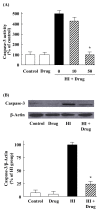Protective effect of 3-(naphthalen-2-yl(propoxy)methyl)azetidine hydrochloride on hypoxia-induced toxicity by suppressing microglial activation in BV-2 cells
- PMID: 27756444
- PMCID: PMC5346314
- DOI: 10.5483/bmbrep.2016.49.12.169
Protective effect of 3-(naphthalen-2-yl(propoxy)methyl)azetidine hydrochloride on hypoxia-induced toxicity by suppressing microglial activation in BV-2 cells
Abstract
We recently reported the anti-inflammatory effects of 3-(naphthalen-2-yl(propoxy)methyl)azetidine hydrochloride (KHG26792) on the ATP-induced activation of the NFAT and MAPK pathways through the P2X7 receptor in microglia. To further investigate the underlying mechanism of KHG26792, we studied its protective effects on hypoxia-induced toxicity in microglia. The administration of KHG26792 significantly reduced the hypoxia-induced expression and activity of caspase-3 in BV-2 microglial cells. KHG26792 also reduced hypoxia-induced inducible nitric oxide synthase protein expression, which correlated with reduced nitric oxide accumulation. In addition, KHG26792 attenuated hypoxiainduced protein nitration, reactive oxygen species production, and NADPH oxidase activity. These effects were accompanied by the suppression of hypoxia-induced protein expression of hypoxia-inducible factor 1-alpha and NADPH oxidase-2. Although the clinical relevance of our findings remains to be determined, these data results suggest that KHG26792 prevents hypoxia-induced toxicity by suppressing microglial activation. [BMB Reports 2016; 49(12): 687-692].
Figures




Similar articles
-
3-(Naphthalen-2-yl(propoxy)methyl)azetidine hydrochloride attenuates MPP+-induced cytotoxicity by regulating oxidative stress and mitochondrial dysfunction in SH-SY5Y cells.BMB Rep. 2018 Nov;51(11):590-595. doi: 10.5483/BMBRep.2018.51.11.123. BMB Rep. 2018. PMID: 29966582 Free PMC article.
-
Anti-inflammatory and anti-oxidative effects of 3-(naphthalen-2-yl(propoxy)methyl)azetidine hydrochloride on β-amyloid-induced microglial activation.BMB Rep. 2017 Dec;50(12):634-639. doi: 10.5483/bmbrep.2017.50.12.189. BMB Rep. 2017. PMID: 29065971 Free PMC article.
-
The azetidine derivative, KHG26792 protects against ATP-induced activation of NFAT and MAPK pathways through P2X7 receptor in microglia.Neurotoxicology. 2015 Dec;51:198-206. doi: 10.1016/j.neuro.2015.10.013. Epub 2015 Oct 30. Neurotoxicology. 2015. PMID: 26522449
-
3-(Naphthalen-2-yl(propoxy)methyl)azetidine hydrochloride attenuates NLRP3 inflammasome-mediated signaling pathway in lipopolysaccharide-stimulated BV2 microglial cells.Biochem Biophys Res Commun. 2018 Jan 1;495(1):151-156. doi: 10.1016/j.bbrc.2017.10.131. Epub 2017 Oct 27. Biochem Biophys Res Commun. 2018. PMID: 29111328
-
Inflammatory neurodegeneration and mechanisms of microglial killing of neurons.Mol Neurobiol. 2010 Jun;41(2-3):242-7. doi: 10.1007/s12035-010-8105-9. Epub 2010 Mar 2. Mol Neurobiol. 2010. PMID: 20195798 Review.
Cited by
-
3-(Naphthalen-2-yl(propoxy)methyl)azetidine hydrochloride attenuates MPP+-induced cytotoxicity by regulating oxidative stress and mitochondrial dysfunction in SH-SY5Y cells.BMB Rep. 2018 Nov;51(11):590-595. doi: 10.5483/BMBRep.2018.51.11.123. BMB Rep. 2018. PMID: 29966582 Free PMC article.
-
Anti-inflammatory effects of N-cyclooctyl-5-methylthiazol-2-amine hydrobromide on lipopolysaccharide-induced inflammatory response through attenuation of NLRP3 activation in microglial cells.BMB Rep. 2021 Nov;54(11):557-562. doi: 10.5483/BMBRep.2021.54.11.082. BMB Rep. 2021. PMID: 34353430 Free PMC article.
-
NRF2 Activation by Nitrogen Heterocycles: A Review.Molecules. 2023 Mar 18;28(6):2751. doi: 10.3390/molecules28062751. Molecules. 2023. PMID: 36985723 Free PMC article. Review.
-
Anti-inflammatory and anti-oxidative effects of 3-(naphthalen-2-yl(propoxy)methyl)azetidine hydrochloride on β-amyloid-induced microglial activation.BMB Rep. 2017 Dec;50(12):634-639. doi: 10.5483/bmbrep.2017.50.12.189. BMB Rep. 2017. PMID: 29065971 Free PMC article.
References
MeSH terms
Substances
LinkOut - more resources
Full Text Sources
Other Literature Sources
Research Materials

